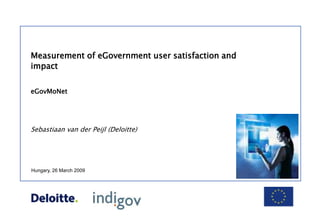Measurement of eGovernment user satisfaction and impact
- 1. Measurement of eGovernment user satisfaction and impacteGovMoNetSebastiaan van der Peijl (Deloitte)Hungary, 26 March 2009
- 2. Introduction to the study approach and objectives Results of the pilot study Next steps: implementing user satisfaction measurement in eGovernment AGENDA
- 3. - 2 -Study approach and objectives
- 4. - 3 -Study approach and objectives: the policy context
- 5. - 4 -Study approach and objectives: a five-step process
- 6. Pilot study results: testing the instrument- 5 -
- 7. - 6 -Pilot study results: supply-use gap for citizensGap between eGovernment supply and use differentiates between services
- 8. - 7 -Pilot study results: supply-use gap for businessGap between eGovernment supply and use is less within a business environment
- 9. Pilot study results: Non-use of eGovernment by level of trust (Citizens)- 8 -Non-use of the Internet for contact with public administrations by level of trust in the Internet and in public administrations: when trust is low % of non-use is higher
- 10. Pilot study results: Reasons for non-use of the Internet (Citizens)- 9 -Creation of Awareness
- 11. Pilot study results: satisfaction with e-services (Citizens)eGovernment is lagging behind in use and satisfaction compared to non-government eServices- 10 -
- 12. Pilot study results: satisfaction with e-services (Business)The difference within the business environment is less- 11 -
- 13. Pilot study results: impact of level of sophistication (Citizens)Satisfaction goes up with the level of interaction of the service- 12 -
- 14. Pilot study results: impact of level of sophistication (Business)The higher the level of interaction the more objectives are achieved- 13 -
- 15. Pilot study results: perceived benefits by citizensPerceived impacts are time-saving, flexibility and simplification- 14 -
- 16. Pilot study results: perceived benefits by businessesPerceived impacts by business are equal- 15 -
- 17. - 16 -Pilot study results: key findings
- 18. - 17 -Next steps: implementation
- 19. - 18 -Next steps: implementation
- 20. - 19 -Next steps: implementation
- 21. Next steps: implementation- 20 -




















